Singer 31K20 Industrial 1937
Hello Dear Friends and readers. I mentioned this machine in the previous post. You can read how the story started here.
After our little side journey to the Repatriation General Hospital Museum, and having seen all the lovely memorabilia, it was established that they did not seem to have any more parts for the machine we had just looked at. So my daughter and myself wandered back to the little opportunity shop. The lady at the desk further explained that the sewing machine I was buying had come from the hospital museum. They had decided for various reasons that the machine was not the kind of item they wanted in the museum. So they had put it in to the Opportunity shop for sale!
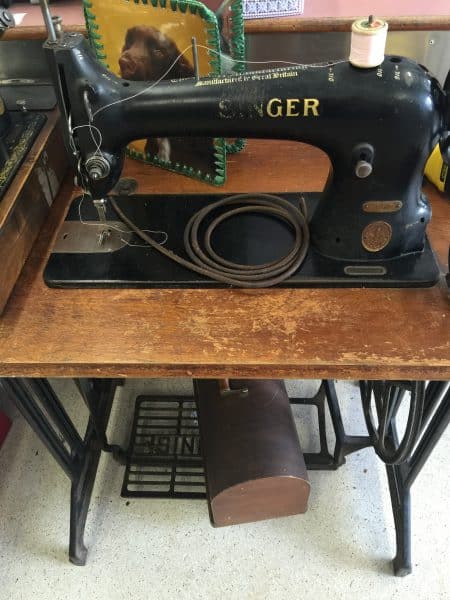
One gentleman referred to it as a canvas machine. I was trying to imagine what items would be made from canvass in a hospital. I was drawing a blank. Perhaps it was used to make the old-fashioned stretchers! However, I do know through personal experience, and prior to decentralisation, that most hospitals would have their own sewing room. This was indeed a place of considerable industry. Here was where all the nurses uniforms were made. They would have made the uniforms for other hospital personnel too. Also doctors coats and nurses capes and caps, along with a variety of purpose made positioning cushions, linen all kinds of mending repairs and any other items as may have directed by the Sisters in Charge or Matrons of the time.
So maybe this is a piece of hospital history after all…..
So getting back to the machine, the next question is of course, how was I going to get it home? I thought I could go home and get a screwdriver and at least undo the screws to remove the sewing machine head. That would reduce the size and weight considerably, as it is quite a lot bigger than a regular machine. Low and behold I looked at the hinges and they were no longer attached. By now we had a veritable throng of elderly ladies interested in how we were going to get this machine out. It was becoming quite comical! Then one of the ladies, I think she may have been close to eighty and bearing a strong Scottish accent insisted that she would help us lift it into the car. She was a powerful lady in body, mind and spirit! So between the gathering force of ladies and with considerable hilarity going on, I lifted out the machine head and took it to the car. I opened the back of the car and then the three of us managed to get the heavy sewing machine frame and table, into the back of the car with the Scottish lady merrily singing about “Donald Where’s yer Troosers”.
It really was hilarious!
Having got the machine home, now comes the fun part of getting it cleaned up and hopefully sewing.
I checked on the ISMICS site for the date checking. https://ismacs.net/singer_sewing_machine_company/serial-numbers/singer-eb-series-serial-numbers.html
I did notice in the shop that oddly, the bobbin case was absent, and the was just a lonely bobbin in the spot where the bobbin case should be.
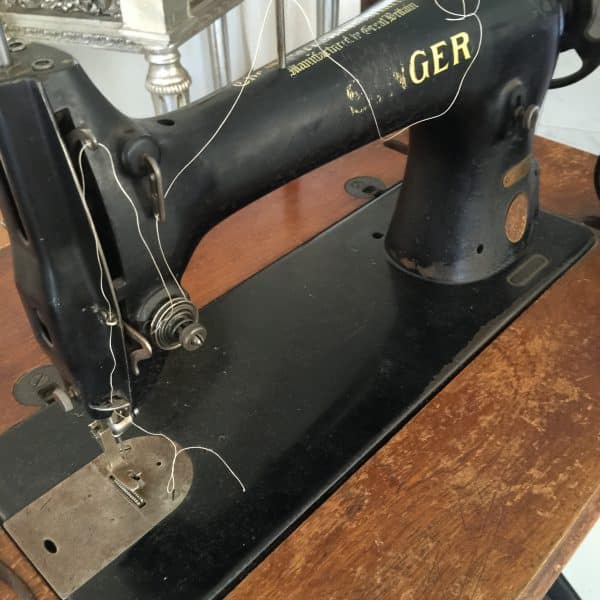
It really is quite a beast. The face plate and rear access plate are both black.
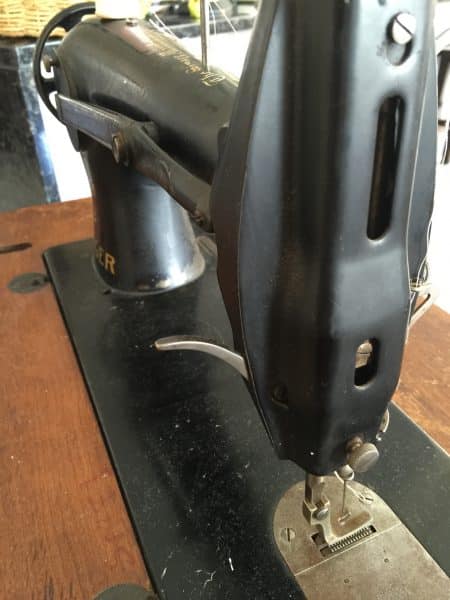
I began in the usual manner of cleaning all the years of greasy dust.
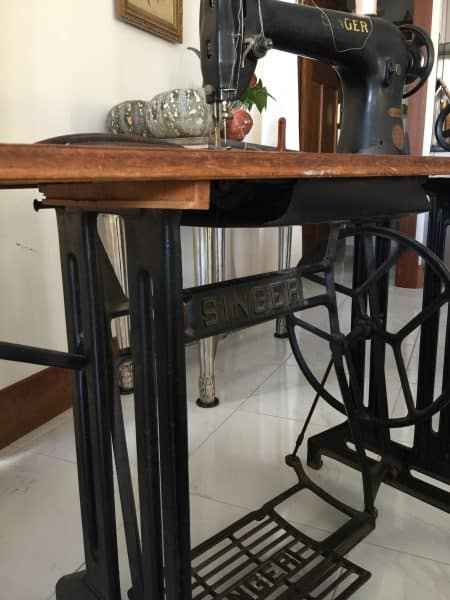
Followed by a good oiling and polishing of the machine and irons with Sewing Machine oil.
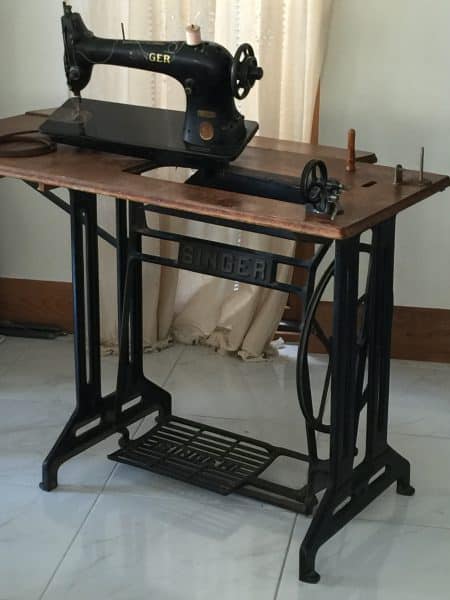
I used Linseed oil to clean up the timber. It does a good job of rehydrating, evening out the colour and sealing the timber surfaces.
Here is a rear view. It shows the extra numbering on the back and how the extension leaves look when they are out.
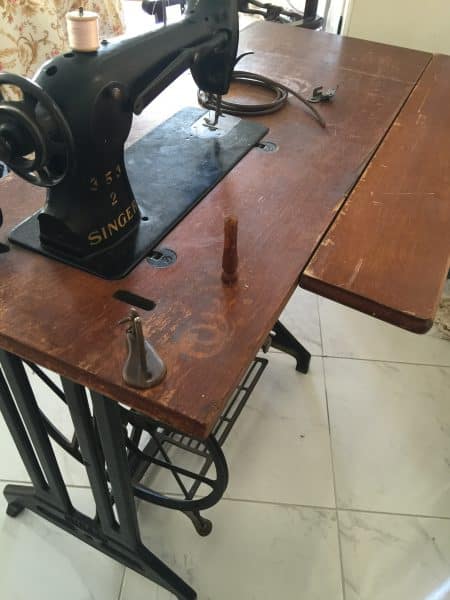
After the machine has been cleaned. I’ve purchased a new belt, as that was perished. All parts are running as smooth as silk. I’ve been told it will not be difficult to purchase a new bobbin case as they are still available for industrial machines.
Incidentally, just to get an idea of the size, here it is pictured with an antique White Peerless 3/4 hand crank machine.
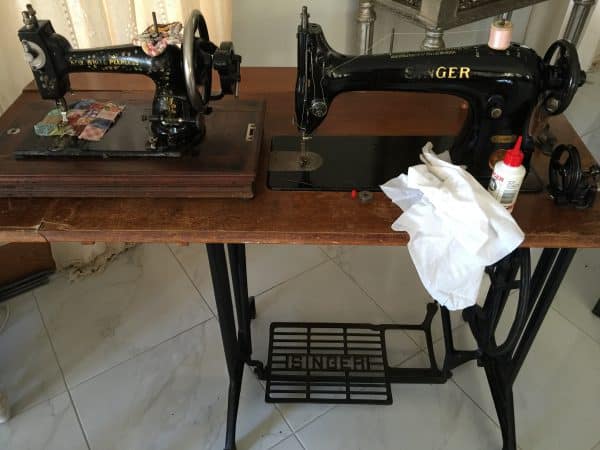
I’m looking forward to seeing how this machine operates and enjoying the large throat space. This is how she looks after the clean up! It really is a Black Beauty!
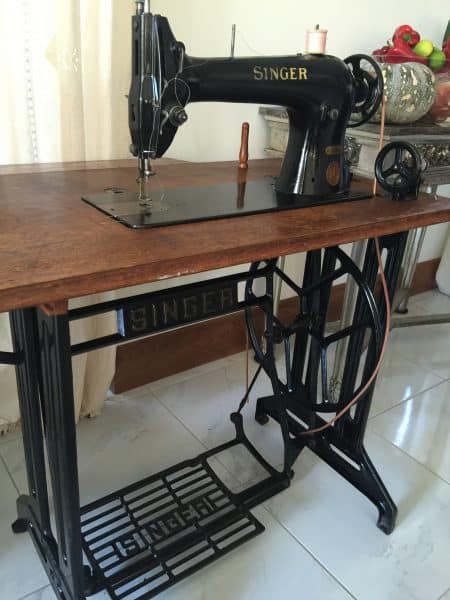
Thank you to all the contributors from Vintage Sewing Machine and Treadle Quilter’s for their advice prior to purchase!
If you enjoyed this post, you may also like
Make Your Singer Sing (Part 1)
New White Peerless Antique Sewing Machine
Antique White USA Treadle Base
Happy treadling.
Susie
© Susan Stuklis 2016

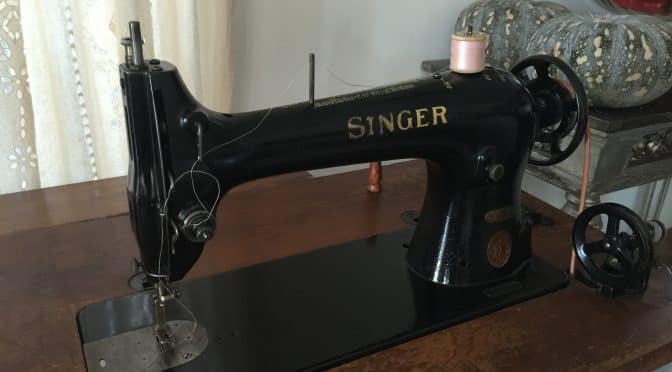
You struck gold on finding this. And congrats on bringing out its beauty. Could you mention the diameter of the pulley wheel? I’ve got a domestic Singer treadle, but the pulley wheel just can’t handle a butter smooth 96-10. Thanks
ps: think of all of those room dividing privacy curtains in hospitals.
Hi Lou,
The Fly Pulley wheel is approximately 16 ½” in diameter. Oh yes so many curtains!
I have one as well. 1937. Looks just like this but mine has drawers. I am trying to figure out what to do with it. I’d like to sell it, but to who?
Hi i have a 31K20 having problems keeping it timed i get it to sew then when i wont to sew through a couple of layer of it drops it timing and no longer sews any ideas why the screw on the needle bar is not holding it place thanks
Are you using the correct needle?
hello from canada… i have my dad’s very old machine that looks just like yours the # says ED130326. so i am not sure of the year. my dad used it to sew leather to make a dog harness for me as a child, and my dog pulled my sleigh. that was back in the early 1960s and it was an old machine back then. I think it was converted to a motorized. I have had it in storage for years, and would like to get it running. my table it is in is not as nice as yours. how did you find out what year it is. can you tell from that serial # i gave you.? any hints you can give me?
Dear Irene, Your machine is a Singer 96K from 1941. Thank you for sharing some of its history which is very interesting. Because4 it is an industrial machine, parts should be readily available. Best of luck.
I’m a bit late, but according to the serial number catalogue it sounds like your machine is from 1941, hope that helps 🙂
https://ismacs.net/singer_sewing_machine_company/serial-numbers/singer-ed-series-serial-numbers.html
Thanks for taking the time to comment. I had previously checked the ISMICS site. It’s definitely 1937. 😊
Lovely story.
My father who was a tailor in his time was given the same type of machine some time ago. He sewed canvas and horse rugs on it. A few years ago he gave it to me to see canvas items. Unfortunately it was recently ruined in an fire. Model 31K20 treadle.
I hope to claim this on insurance but dont know the value of it.
Can anyone help.
Dear Lee, I’m so sorry to read this. How sad. The sentimental value can never be replaced. Annecdotally I was told these machines can bring approximately $800- Australian, (depending on condition). Any other ideas from our readers would be welcome.
I have the same machine and I want to restore it, are you able to tell me the diameter of the Band Wheel? (The treadle wheel underneath)
Cheers.
I have inherited this machine from my late father inlaw,he was an upholsterer,unfortunately the bobin case is broken and not sure how to tighten bobbin thread, any thoughts of you could help me,i am rural south Australia, patricia
Dear Patricia, The bobbin case was missing from mine when I acquired this machine. I was able to get a replacement. I recommend you get in contact with Colin Harper at Elizabeth Machines..The address is 205 Sturt Street, Adelaide. South Australia 5000. The number is 82117368.
They should be able to help you. Because your machine is classed as industrial, parts are still available. Wishing you every success!
Susie
Help I have one of these machines and it has decided not to pick up the bottom thread. I have no idea how to fix it. Any suggestions?
Hi Del. What a great machine! How lucky for you. My suggestion is to give it a good clean and oil. Make sure the bobbin race is clean of threads and debris. Then check your needles. I suspect it wont pick up the thread wiout the correct needles. This machine requires these needles to sew.
Canu: 14:25 1
NM:100 Size 16
DBX1 16X231 287 WH 1738(A)
Good Luck!
Susie, you have an unusual treadle stand that Singer called a “convertible”. They were produced during the early years of electrification, and were designed to be convertible between manual and electric operation. The wooden top on yours is not drilled for the three motor mounting bolts, but it has the 2-piece pitman rod. The little coupling nut just above the foot plate could be quickly undone from the flywheel upper rod, and connected to an upper rod attached to a motor controller of clutch motor. The stand could be bought as a treadle and used until electricity became available, and then easily converted to a power stand. I have one like it that took me nine years to find a replacement coupling nut for it. I now have it set up to treadle my Singer 95-40 and my Singer 20U. My 31-15 that came with my convertible stand is in another industrial treadle.
You have a very nice treadle there!
CD in Oklahoma
Dear CD. Thank you so much for sharing this valuable knowledge and taking the time to comment. I really appreciate this!
I just recently found your blog and am loving reading all of it! I’m just getting into Free Motion Quilting on vintage machines. I’m having fun learning (sometimes frustrating, but not giving up).
I’m wondering what models all of your vintage machines are that you have now? Also, which is your favorite for FMQ? Thanks and keep your wonderful posts coming 😊
Dear Jenny. Thank you for your comments. I’m written posts on all the vintage machines I have, under sewing machines vintage and antique. At present, I free motion quilt on a Singer 201K in a cabinet. It’s electric so it’s pretty fast. I’ve read that many people prefer to quit on a Singer 15, I think in part due to the big vertical bobbin. I’m yet to try it – but looking forward to treadle quilting too – eventually….will post when I do.
Oh Susie this was a wonderful story. What fun you had. This machine looks exactly like one I inherited when I bought a rubber mattress making business on my. Arrival in Queensland in 1970. I knew nothing about manufacturing and covering heavy latex foam (NOT polyurethane foam) mattresses but I could sew!
The machine was a wonderful, heavy industrial one but unlike yours, it was electric although it still had its treadle. It was an amazing work beast and I do so wish I still had it. It could, and did, sew everything and anything I threw at it provided I was patient and treated it with respect.
I learned a lot about a lot of things for the years I ran the business and when I sold,it for virtually nothing, the machine went with it. I suspect the new owner never did make any more mattresses or cushions and probably quickly discarded the whole thing, including the wonderful machine.
On another note, I very much enjoy your postings.
Oh Jan, thank you for sharing this..makes me sad that you no longer have it!!! I know who to come to for advice now!
Amazing! Wonderful find.
Wow what a find… if only it could talk!!
I think I have fallen in love.